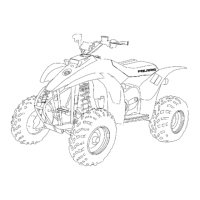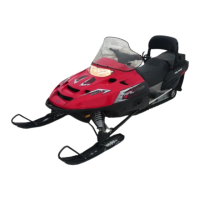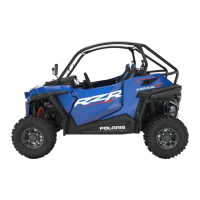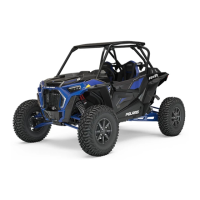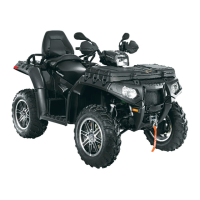65
OPERATION
Hauling Carg o
Hauling cargo improperly can alter vehicle handling and may
cause loss of control or brake instability and result in serious
injury or death. Always follow these precautions when hauling
cargo:
S REDUCE SPEED AND ALLOW GREATER DISTANCE FOR
BRAKING WHEN HAULING CARGO.
S CARGO WEIGHT DISTRIBUTION should be 1/3 on the front
rack and 2/3 on the rear rack. When operating over rough or
hilly terrain, reduce speed and cargo to maintain stable driv-
ing conditions. Carrying loads on one rack only increases the
possibility of vehicle overturn.
S LOADS MUST BE CARRIED AS LOW ON THE RACKS AS
POSSIBLE. Carrying loads high on the racks raises the cen-
ter of gravity of the vehicle and creates a less stable operat-
ing condition. When cargo loads are carried high on the
racks, the weight of the loads must be reduced to maintain
stable operating conditions.
S ALL LOADS MUST BE SECURED BEFORE OPERATING.
Unsecured loads can create unstable operating conditions,
which could result in loss of control of the vehicle.
S OPERATE ONLY WITH STABLE AND SAFELY ARRANGED
LOADS. When handling off-centered loads that cannot be
centered, securely fasten load and operate with extra cau-
tion. Always attach the tow load to the hitch point designated
for your vehicle.
S HEAVY LOADS CAN CAUSE BRAKING AND CONTROL
PROBLEMS. Use extreme caution when applying brakes
with a loaded vehicle. A void terrain or situations that may
require backing downhill.
S EXTREME CAUTION MUST BE USED when operating with
loads extending over the rack sides. Stability and maneuver-
ability may be adversely affected, causing the machine to
overturn.
S DO NO T BLOCK THE FRONT HEADLIGHT BEAM when
carrying loads on the front rack.
S DO NO T TRAVEL FASTER THAN THE RECOMMENDED
SPEEDS. Vehicle should never exceed 10 mph (16 kph)
while towing a load on a level grass surface. Vehicle speed
should never exceed 5 mph (8 kph) when towing loads in
rough terrain, while cornering, or while ascending or de-
scending a hill.
WARNING

